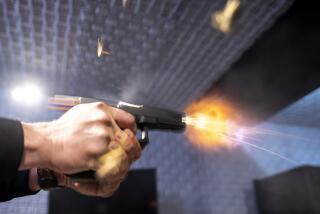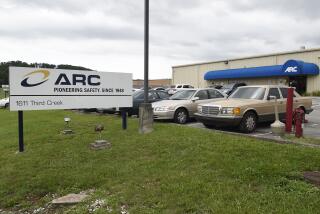Firm Used Air Bags to Cushion Defense Drop
- Share via
NEWHALL — Air bags can save lives. They can also save a company.
In 1990, the year after the Berlin Wall came down, a modest-sized Newhall defense contractor, Special Devices Inc., jumped full tilt into selling trigger devices called initiators, which were similar to those it produced for Tomahawk missiles, to makers of automotive air bags.
Since then, the company’s profits have jumped fivefold, sales have quadrupled and its net worth has tripled. About 80% of its business now comes from automotive sales. Special Devices’ parts for air bags are installed in cars from GM, Ford, Chrysler, Europe and Japan.
In recent months, however, there has been controversy over the dangers of air bags. Studies have shown that 68 people, including 40 children, have been killed by air bags that were deployed too forcefully.
So what is the prognosis for Special Devices?
Demand for the company’s products is likely to increase because TRW, Morton and other major air bag manufacturers will shift into producing multiple-sensor “smart bags” that vary, or slow, the explosion rate of air bags to make them safer for children and elderly passengers.
“There hasn’t been any slowdown for Special Devices, and as smart bags come in, that would increase the requirements for initiators. This should be a good opportunity for Special Devices,” said Gary Krieger, analyst with Olde Discount Corp. in Detroit, an investment-banking firm.
Special Devices is already straining to keep up with demand. Its Newhall plant is running three shifts and operating 24 hours a day, five days a week.
“We see our business growing quite substantially over the next few years,” said John Cuthbert, Special Devices vice president and head of its automotive division.
For the six months that ended May 4, Special Devices’ net income jumped 52% to $4.4 million on a 29% rise in sales to $60.3 million. In the current fiscal year, Krieger expects Special Devices’ profit to hit $10 million, marking its fourth consecutive year of record profits.
Air bags are activated when a sensor tracks a crash and transmits an electric charge to an initiator, the Special Devices component. That device triggers an explosion of fuels and chemicals packed inside metal housings, which in turn ignites gases to inflate the air bag, which blasts out of the dashboard at about 200 mph. All this happens in 40 milliseconds.
Two decades ago, the National Highway Traffic Safety Administration predicted that when air bags were fully installed they would save 12,000 lives a year. That safety goal has proved elusive.
Nonetheless, the NHTSA says that air bags have saved 2,055 lives so far, while 68 people have died from their deployment. Some deaths occurred when passengers failed to buckle their seat belts or because drivers placed infants in child seats in the front of a car. The NHTSA now says that children under 12 should not ride in the front of a car but should stay buckled in the back seat.
But the deaths, and graphic videos of simulated crashes showing children test dummies propelled inside cars like rag dolls after being hit by air bags, have rallied attention to the potential dangers. As Car and Driver magazine put it, “Blasting our way to safety looks less promising every day.”
Last winter, the NHTSA proposed allowing consumers to have air bags disconnected. But auto makers objected, and the agency is now reviewing its final recommendations.
Car makers oppose widespread use of on-off switches for air bags, citing safety issues and the fear of being sued after accidents if someone forgets to turn on an air bag. “Most air bag deaths are from carelessness. So it’s unlikely that air bags will ever become optional,” Krieger said.
The more likely answer, he said, is developing “smart bags” that can vary air bag inflation speeds and volume after sensors measure the size of the crash and track where a passenger is seated and how much the person weighs. “The simplest way to do that is to have two-stage inflaters. And the good thing for us is it would require two initiators,” Cuthbert said.
Despite recent safety concerns, Ellen Adnopoz, with Axe Houghton Associates, a Port Chester, N.Y., investment firm that owns 5% of Special Devices’ stock, does not anticipate any sudden drop in air bag sales. “We’re a long ways away from that happening,” she said.
One reason Special Devices keeps growing is that federal regulations, set in place long ago, continue to phase in more air bags. Come September, 100% of new passenger cars and 80% of light trucks and vans sold in the U.S. must have air bags for drivers and front-seat passengers.
Despite Special Devices’ successful shift from being a defense contractor to one that thrives in the commercial market, its stock has not enjoyed the same explosive growth. The company went public in 1991 at $9.50 a share, and on Monday its stock closed at $15.875 a share.
Granted, Special Devices still faces some worries.
The company has grown like a weed primarily because air bag maker TRW has been a major client, in some years accounting for 60% of its sales.
Last year Morton, another air bag maker, became a big customer. Still, about 75% of Special Devices’ sales this year will come from only two clients, and there is always a possibility that customers could start making their own initiators instead of buying them. “That’s sort of scary,” Cuthbert conceded.
His customers, Cuthbert said, “have dabbled with making their own initiators.”
But these tiny trigger devices are a special breed of explosives, and after three decades of making them for the Defense Department, Special Devices seems to have mastered the process.
“It’s not as easy as you think,” he said, and some air bag makers are “a little intimidated by it.” He envisions that his customers may one day make 10% to 20% of the trigger devices themselves.
Special Devices is also locked in a fierce price-cutting battle with rival OEA Inc., based in Denver. Initiator prices have dropped 40% in the last four years, and Cuthbert expects prices to keep going south. All this keeps the pressure on Special Devices to operate more efficiently.
The company opened a plant in Mesa, Ariz., six years ago to be near TRW’s plants. But Special Devices is trying to boost overall production from 25 million to 40 million initiators a year, and it has outgrown its space in Newhall. So Special Devices purchased 280 acres in Moorpark, where it expects to move its headquarters and open a production plant next year.
Air bag sales are also picking up in Europe and Asia, and Special Devices’ products are now in Fiats, Rovers, Saabs and Jaguars.
The driving force behind all this growth is the safety record of air bags.
Cuthbert tells a story about two of his daughter’s friends who were killed when they fell asleep while driving at night.
“If the car had been equipped with air bags, they would have been saved,” he said. “There are a lot of cases like that.”
More to Read
Inside the business of entertainment
The Wide Shot brings you news, analysis and insights on everything from streaming wars to production — and what it all means for the future.
You may occasionally receive promotional content from the Los Angeles Times.











